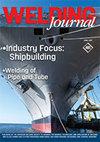焊接残余应力和变形预测的最新进展-第1部分
IF 1.4
3区 材料科学
Q2 METALLURGY & METALLURGICAL ENGINEERING
引用次数: 10
摘要
残余应力和变形是焊接热输入、材料的高温响应和接头约束条件之间复杂相互作用的结果。焊接残余应力和变形都会严重损害焊接结构的性能和可靠性。在过去的二十年里,在预测和减轻焊缝残余应力和变形方面取得了许多重大而令人兴奋的进展。本文从数值模拟理论和方法的角度,综述了焊接残余应力和变形预测的最新进展。本文涵盖的预测方法包括热力冶金方法、简化分析方法、搅拌摩擦焊接建模方法、屈曲变形预测方法、焊接云计算方法、集成制造工艺建模和集成计算材料工程(ICME)焊接建模。还讨论了剩余的挑战和新的发展,以指导未来对焊接残余应力和本文章由计算机程序翻译,如有差异,请以英文原文为准。
Recent Advances in the Prediction of Weld Residual Stress and Distortion - Part 1
Residual stresses and distortions are the result of complex interactions between welding heat input, the material’s high-temperature response, and joint constraint conditions. Both weld residual stress and distortion can significantly impair the performance and reliability of welded structures. In the past two decades, there have been many significant and exciting developments in the prediction and mitigation of weld residual stress and distortion. This paper reviews the recent advances in the prediction of weld residual stress and distortion by focusing on the numerical modeling theory and methods. The prediction methods covered in this paper include a thermo-mechanical-metallurgical method, simplified analysis methods, friction stir welding modeling methods, buckling distortion prediction methods, a welding cloud computational method, integrated manufacturing process modeling, and integrated computational materials engineering (ICME) weld modeling. Remaining challenges and new developments are also discussed to guide future predictions of weld residual stress and
求助全文
通过发布文献求助,成功后即可免费获取论文全文。
去求助
来源期刊

Welding Journal
工程技术-冶金工程
CiteScore
3.00
自引率
0.00%
发文量
23
审稿时长
3 months
期刊介绍:
The Welding Journal has been published continually since 1922 — an unmatched link to all issues and advancements concerning metal fabrication and construction.
Each month the Welding Journal delivers news of the welding and metal fabricating industry. Stay informed on the latest products, trends, technology and events via in-depth articles, full-color photos and illustrations, and timely, cost-saving advice. Also featured are articles and supplements on related activities, such as testing and inspection, maintenance and repair, design, training, personal safety, and brazing and soldering.
 求助内容:
求助内容: 应助结果提醒方式:
应助结果提醒方式:


